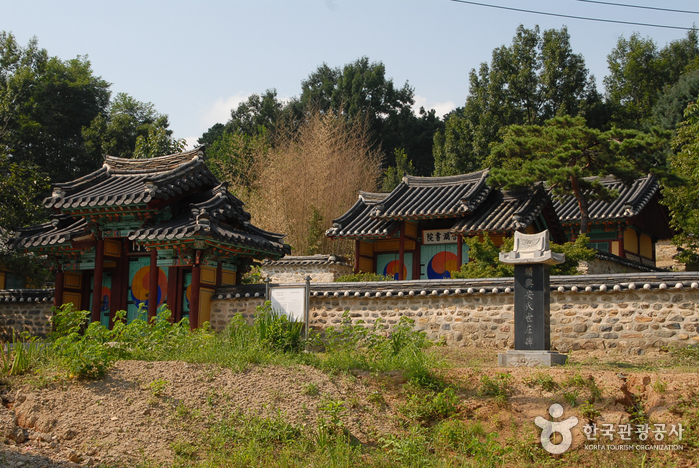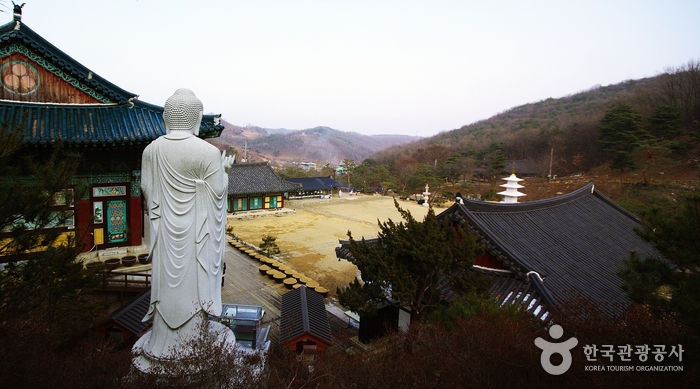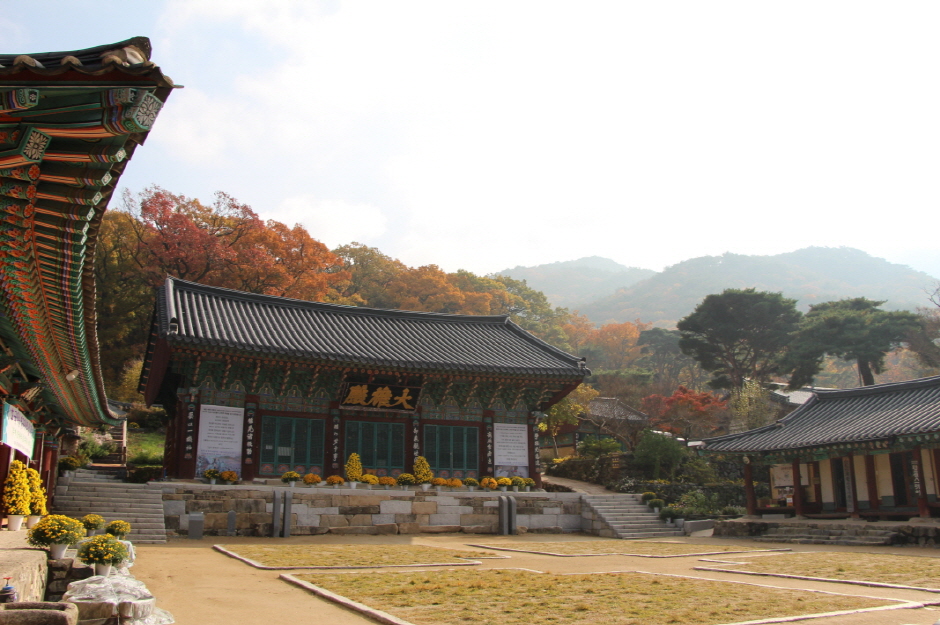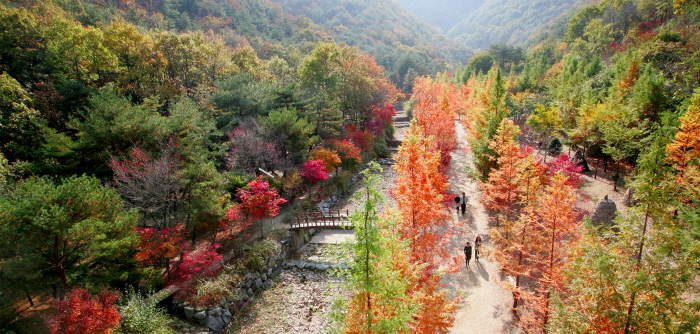Haposeowon Confucian Academy (합호서원)
16.9Km 2025-05-20
262-6, Wonhapgang 1-gil, Yeondong-myeon, Sejong
+82-44-330-5832
Registered as Cultural Heritage Material, Haposeowon Confucian Academy is where the spiritual tablet of An Hyang, a respected scholar during the Goryeo period, is enshrined. The academy was founded in 1716 by the scholar's descendants, who held regular memorial services until a royal order to close down most seowon institutions was made in the late Joseon dynasty. In 1949, Haposeowon Confucian Academy was rebuilt as an affiliated institution with the consent of 218 local Confucian schools nationwide.
Presidential Archives (대통령기록전시관)
17.0Km 2025-05-20
250 Dasom-ro, Sejong-si
The Presidential Archives offers an immersive journey through modern Korean history with documents, photos, and videos of South Korea's past presidents. It includes an exhibition hall, a children’s experience hall, and a video theater. The president’s office and reception room have been faithfully recreated, and displays include diplomatic gifts, souvenirs, and official vehicles used by past presidents. Children can engage in fun activities like becoming a president, creating election posters and participating in voting simulations.
Lotte Himart - Sejong Branch [Tax Refund Shop] (롯데하이마트 세종점)
17.1Km 2025-05-20
363, Galmae-ro, Sejong-si
-
E-An Land (이안숲속)
17.2Km 2020-04-24
25, Sumogwon-gil, Gongju-si, Chungcheongnam-do
+82-41-855-2008
E-An Land Forest was established in 1999 when 1,836 arbor species and 1,418 herb species were planted on a land area of 1,118 hectares. The forest features a tropical garden and various other exhibition gardens, as well as thematic spaces like the Haneul Maru. The forest was finally completed in 2006. Inside the arboretum, there are various things to see such as the herb village, parakeet exhibitions, a pine tree garden, and man-made cave. There is also a mini golf course and an outdoor swimming pool. Visitors can also use the onsite pensions and the auto camping site for accommodation, making the E-An Land Forest a great place for family and group visitors.
Munui Cultural Properties Site (문의문화재단지)
17.3Km 2022-12-27
721, Daecheonghoban-ro, Sangdang-gu, Cheongju-si, Chungcheongbuk-do
Munui Cultural Properties Site, overlooking the Daecheongho Lake, attracts many visitors. The site was created to preserve and promote the local traditional culture of Cheongwon (Chungcheongbuk-do); it is a great place to learn about local history, culture, and arts.
The spacious complex (132,232m²) is a home to ten traditional houses (Munsangwan, aristocrat houses, a museum, and a tavern), showing a form of a traditional village. It is also full of dolmen stones (symbolizing abundant procreation), Jangseung (totem poles at the entrance of villages or temples), and Yeonjabanga (millstones worked by horses or oxen), providing visitors with opportunities to learn about traditional culture and life.
With a theme of roof tiles, a relics gallery in the complex boasts over 774 local items, categorized by historical period (e.g. the Silla Period, Baekje Period, etc.). Munsan-ri Stone Bridge, believed to have been built during the Goryeo Period, was restored in front of the gallery.
The complex also offers a wide array of amenities including mineral spring sites, playgrounds, and Munui Movie Village (a drive-in movie theatert). Nearby notable attractions include artificial falls, Yangseongsan Mountain, Jakdusan Mountain, Daecheongho Lake, Nosan Pine Forest, Donghwasa Temple, and Bugang Mineral Springs.
Sangsoo Herb Land (상수허브랜드)
17.3Km 2020-07-10
18, Buyongoecheon-gil, Seowon-gu, Cheongju-si, Chungcheongbuk-do
+82-43-277-6633
Sangsoo Herb Land is an arboretum which houses 1,000 species of herbs throughout its 82,645㎡ (25,000 pyeong) area. The glass greenhouse, spanning over 9,917㎡ (3,000 pyeong), keeps herbs fresh and green, even in the winter season. Herb Land is well-known for their flowers that bloom year-round, as well their diverse events including the Herb Land Festival held in May each year, wedding ceremonies, banquets, hands-on program classes, and more.
Sangsoo Herb Land provides a wide array of programs for visitors. The major event is the Herb Land Festival, aiming to spread knowledge on the use of diverse herbs, including introducing the aromatic value of herb plants in landscaping and as a natural insecticide, as well as the health benefits of herbal foods. Participants can take part in seminars and hands-on activities to learn more about herbs.
The banquet room on the second floor can accommodate large groups for events, serving excellent herb dishes at reasonable prices. An outdoor wedding service surrounded by beautiful gardens is also available.
Yeongpyeongsa Temple (영평사)
17.6Km 2021-11-01
124, Yeongpyeongsa-gil, Sejong-si
+82-44-857-1854
A branch of Magoksa Temple, which is the 6th local temple of the Jogyejong Order, Yeongpyeongsa Temple has six traditional buildings and three small hermitages. Janggunsan Mountain, where the temple is located, is small but full of energy. According to Feng Shui, the mountain is a perfect location for a temple because it is shaped like a dragon curled along the Geumgang River. Yeongpyeongsa is a tranquil place that captures the purity of the temple’s Buddhist practice, with fresh air and clean water that offer a habitat for fireflies, crawfish, and black snails. On the way in, visitors are greeted by a multitude of wildflowers vying for their attention: the columbines and the prairie crocuses in spring, the white lotuses in summer, and the Siberian chrysanthemums in autumn.
Gapsa Temple (갑사)
17.6Km 2021-12-17
567-3, Gapsa-ro, Gongju-si, Chungcheongnam-do
+82-41-857-8981
Gapsa Temple is located in the forested foothills of Gyeryongsan Mountain, 19 kilometers from Gongju and a three-hour walk from Donghaksa Temple. The temple is most beautiful during fall when surrounded by crimson foliage. Gapsa Temple was established by monk Adohwasang in 420, during the early Baekje Period. The temple's beauty allowed it to escape destruction many times, but it was ultimately burned down during the Imjin War (1592-1598). The current structures were built in 1604. Nearby attractions include Yongmunpokpo Falls, Sujeongbong Peak, and Cheonjinbotab Pagoda.
Bangchukcheon Musical Fountain (방축천 음악분수)
17.7Km 2025-05-20
450-25 Eojin-dong, Sejong-si
Located in Bangchukcheon Riverside Park, the fountain showcases vibrant water streams synchronized with lively music. It creates a captivating spectacle at night, making it a popular nighttime destination. It operates every evening from 20:30 to 20:50, from May to October. The park also features a waterfront plant-themed area, Sejong Plaza, and an ecology learning center.
Sangso-dong Forest Park (상소동 산림욕장)
17.9Km 2022-12-26
San 1-1, Sangso-dong, Dong-gu, Daejeon
+82-42-251-4771
Sangso-dong Forest Park is located at the point where the foothills of Maninsan Mountain and Sikjangsan Mountain meet. The road to the park is beautifully lined with sycamore trees. The park offers various facilities for enjoying nature and in particular, the stone pagodas placed throughout the park are a must-see. Visitors can stack their own rocks and make wishes relating to family, health, relationships, and more. The park is great for walks, hikes, or even just to relax as wild flowers bloom all throughout spring to fall.


![Lotte Himart - Sejong Branch [Tax Refund Shop] (롯데하이마트 세종점)](http://tong.visitkorea.or.kr/cms/resource/79/2883179_image2_1.jpg)




 English
English
 한국어
한국어 日本語
日本語 中文(简体)
中文(简体) Deutsch
Deutsch Français
Français Español
Español Русский
Русский